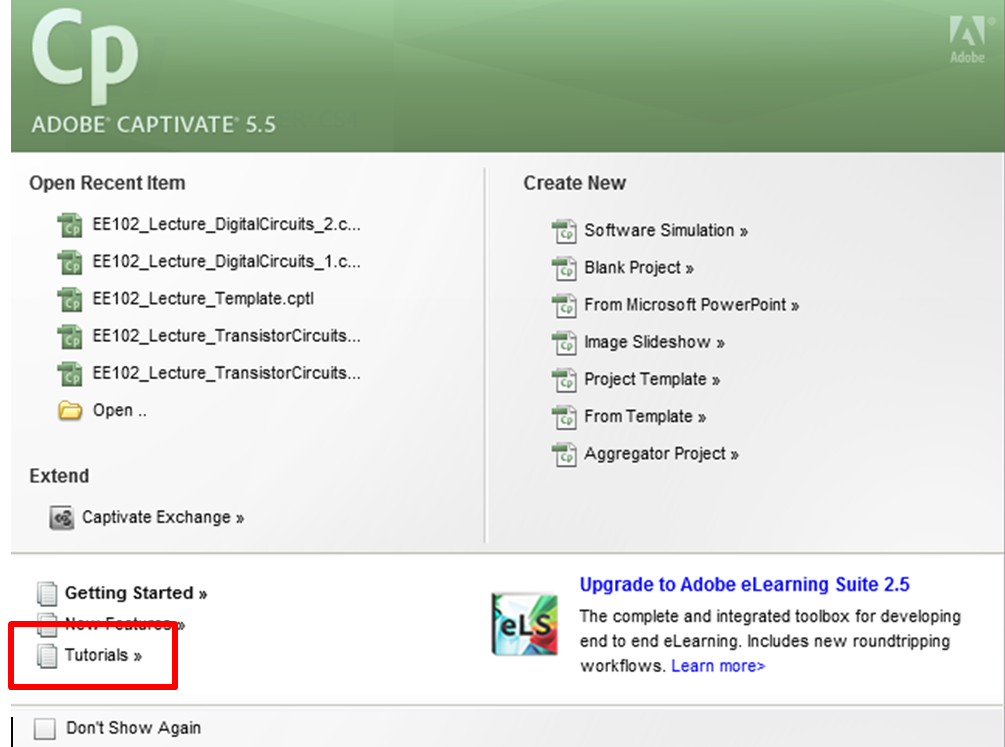There are many technology tools out there that can help you get information to your students and free up class time for deeper, more active learning. Here are a few of the tools we have found that work for us. Screencast software: There are several methods available to record a video of a computer screen with voice narration. These tools are becoming increasingly powerful and can include quizzes, inserted video clips, etc. Camtasia and Captivate are both free through the UAF site license. Adobe Captivate Adobe Captivate provides several tutorials to get you started in a variety of tasks. You can access these tutorials when you start the program  or just go directly to https://www.adobe.com/support/captivate/gettingstarted.html Technology in action: EE102, EE 443 Other video tools: Our advice is to use whatever you are most comfortable with! There are lots of other tools for creating and editing videos with similar capabilities: Adobe Premier pro (program and training videos available via UAF site license), Avid (industry standard), iMovie, Final cut pro 10x. But the learning curve is pretty high on each of these tools, so pick one and stick with it. Technology blooper reel Simple video lectures Research has shown that students are more engaged by videos with people in them than screencasts. The FIZZ method is a great alternative that is a hybrid lecture on video. More on the FIZZ method Technology in action: CHEM 212 Course management tools: Blackboard (Thorsen) Technology in action: EE102 More technology in the classroom: Clickers: clicker response systems are often used for quizzes or taking attendance, but they also have the potential to be powerful tools for assessing student understanding. Instructors can insert multiple choice questions that check for conceptual understanding into the middle of a powerpoint lecture. Student responses are immediate and anonymous, which really gives the instructor a true sense of where the students are at in terms of understanding concepts. Pencasting A pencast is a powerful way that you can demonstrate problems for students outside of class. The end product is a pdf file with audio that shows what what you are writing during narration. Thus, you can articulate what you are thinking while working a problem and help students train themselves to think through problems. We are all using Livescribe pens. Pencasting Introduction Livescribe Pen- Getting Started Instructions Redomended tutorials: Tutorial 1 Tutorial 2 Livescribe website Technology in action: CHEM 212, EE 443
or just go directly to https://www.adobe.com/support/captivate/gettingstarted.html Technology in action: EE102, EE 443 Other video tools: Our advice is to use whatever you are most comfortable with! There are lots of other tools for creating and editing videos with similar capabilities: Adobe Premier pro (program and training videos available via UAF site license), Avid (industry standard), iMovie, Final cut pro 10x. But the learning curve is pretty high on each of these tools, so pick one and stick with it. Technology blooper reel Simple video lectures Research has shown that students are more engaged by videos with people in them than screencasts. The FIZZ method is a great alternative that is a hybrid lecture on video. More on the FIZZ method Technology in action: CHEM 212 Course management tools: Blackboard (Thorsen) Technology in action: EE102 More technology in the classroom: Clickers: clicker response systems are often used for quizzes or taking attendance, but they also have the potential to be powerful tools for assessing student understanding. Instructors can insert multiple choice questions that check for conceptual understanding into the middle of a powerpoint lecture. Student responses are immediate and anonymous, which really gives the instructor a true sense of where the students are at in terms of understanding concepts. Pencasting A pencast is a powerful way that you can demonstrate problems for students outside of class. The end product is a pdf file with audio that shows what what you are writing during narration. Thus, you can articulate what you are thinking while working a problem and help students train themselves to think through problems. We are all using Livescribe pens. Pencasting Introduction Livescribe Pen- Getting Started Instructions Redomended tutorials: Tutorial 1 Tutorial 2 Livescribe website Technology in action: CHEM 212, EE 443
Faculty Learning Community on Flipped Classrooms
Best Practices – What's Worked In Our Classrooms
